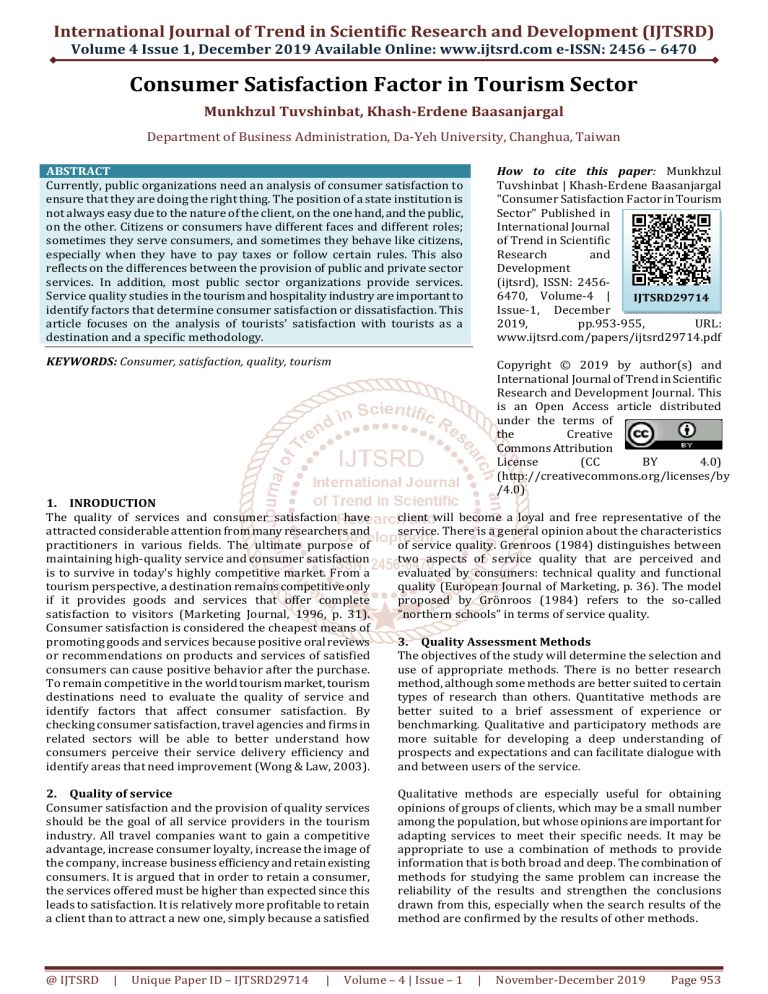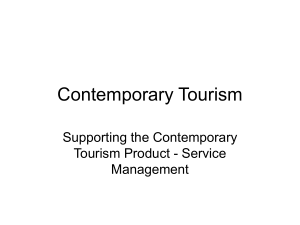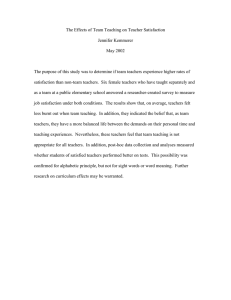
International Journal of Trend in Scientific Research and Development (IJTSRD) Volume 4 Issue 1, December 2019 Available Online: www.ijtsrd.com e-ISSN: 2456 – 6470 Consumer Satisfaction Factor in Tourism Sector Munkhzul Tuvshinbat, Khash-Erdene Baasanjargal Department of Business Administration, Da-Yeh University, Changhua, Taiwan ABSTRACT Currently, public organizations need an analysis of consumer satisfaction to ensure that they are doing the right thing. The position of a state institution is not always easy due to the nature of the client, on the one hand, and the public, on the other. Citizens or consumers have different faces and different roles; sometimes they serve consumers, and sometimes they behave like citizens, especially when they have to pay taxes or follow certain rules. This also reflects on the differences between the provision of public and private sector services. In addition, most public sector organizations provide services. Service quality studies in the tourism and hospitality industry are important to identify factors that determine consumer satisfaction or dissatisfaction. This article focuses on the analysis of tourists' satisfaction with tourists as a destination and a specific methodology. How to cite this paper: Munkhzul Tuvshinbat | Khash-Erdene Baasanjargal "Consumer Satisfaction Factor in Tourism Sector" Published in International Journal of Trend in Scientific Research and Development (ijtsrd), ISSN: 24566470, Volume-4 | IJTSRD29714 Issue-1, December 2019, pp.953-955, URL: www.ijtsrd.com/papers/ijtsrd29714.pdf KEYWORDS: Consumer, satisfaction, quality, tourism Copyright © 2019 by author(s) and International Journal of Trend in Scientific Research and Development Journal. This is an Open Access article distributed under the terms of the Creative Commons Attribution License (CC BY 4.0) (http://creativecommons.org/licenses/by /4.0) 1. INRODUCTION The quality of services and consumer satisfaction have attracted considerable attention from many researchers and practitioners in various fields. The ultimate purpose of maintaining high-quality service and consumer satisfaction is to survive in today's highly competitive market. From a tourism perspective, a destination remains competitive only if it provides goods and services that offer complete satisfaction to visitors (Marketing Journal, 1996, p. 31). Consumer satisfaction is considered the cheapest means of promoting goods and services because positive oral reviews or recommendations on products and services of satisfied consumers can cause positive behavior after the purchase. To remain competitive in the world tourism market, tourism destinations need to evaluate the quality of service and identify factors that affect consumer satisfaction. By checking consumer satisfaction, travel agencies and firms in related sectors will be able to better understand how consumers perceive their service delivery efficiency and identify areas that need improvement (Wong & Law, 2003). 3. Quality Assessment Methods The objectives of the study will determine the selection and use of appropriate methods. There is no better research method, although some methods are better suited to certain types of research than others. Quantitative methods are better suited to a brief assessment of experience or benchmarking. Qualitative and participatory methods are more suitable for developing a deep understanding of prospects and expectations and can facilitate dialogue with and between users of the service. 2. Quality of service Consumer satisfaction and the provision of quality services should be the goal of all service providers in the tourism industry. All travel companies want to gain a competitive advantage, increase consumer loyalty, increase the image of the company, increase business efficiency and retain existing consumers. It is argued that in order to retain a consumer, the services offered must be higher than expected since this leads to satisfaction. It is relatively more profitable to retain a client than to attract a new one, simply because a satisfied Qualitative methods are especially useful for obtaining opinions of groups of clients, which may be a small number among the population, but whose opinions are important for adapting services to meet their specific needs. It may be appropriate to use a combination of methods to provide information that is both broad and deep. The combination of methods for studying the same problem can increase the reliability of the results and strengthen the conclusions drawn from this, especially when the search results of the method are confirmed by the results of other methods. @ IJTSRD | Unique Paper ID – IJTSRD29714 | client will become a loyal and free representative of the service. There is a general opinion about the characteristics of service quality. Grenroos (1984) distinguishes between two aspects of service quality that are perceived and evaluated by consumers: technical quality and functional quality (European Journal of Marketing, p. 36). The model proposed by Grönroos (1984) refers to the so-called “northern schools” in terms of service quality. Volume – 4 | Issue – 1 | November-December 2019 Page 953 International Journal of Trend in Scientific Research and Development (IJTSRD) @ www.ijtsrd.com eISSN: 2456-6470 The SERVQUAL model is currently widely used, but the model has been criticized for 5 dimensions that are so general that they can limit their usefulness in certain contextual services. This model, developed by Berry (2011), identified 5 key parameters of service quality: reliability, responsiveness, confidence, empathy and tactility. Over time, the SERVQUAL model has been successfully used in the tourism sector, where some important studies were carried out, studies that showed that in different parts of the global quality is perceived differently by tourists. Since tourism has a wide cultural spectrum, it is important for service providers to determine whether cross-cultural differences play an important role in assessing consumer satisfaction. Consumer satisfaction is not generally accepted; Over time, researchers came to the conclusion that people perceive and evaluate satisfaction with the quality of service differently, depending on cultural background, previous experience and other external factors that cannot be directly controlled by service providers. This conceptual model of service quality assumes that service failures and subsequent consumer dissatisfaction are caused by five collisions or inconsistencies that, in order to remain viable, service providers in all sectors should strive to close: Collision 1: between consumer expectations and management perceptions. This collision occurs when management does not perceive what consumers want. Collision 2: between the perception of management and the specification of the quality of service: although management may correctly perceive what the consumer wants, it may not set an appropriate performance standard. Collision 3: between the quality of service specification and the provision of services. This collision may arise due to poor training, inability or unwillingness of service personnel to comply with the established standard of service. Collision 4: between the provision of services and external communication: consumer expectations are highly dependent on statements from company representatives and advertisements. The collision occurs when these anticipated expectations are not met during the provision of the service. Collision 5: between expected service and experienced service. This collision occurs when the consumer misinterprets the quality of service. This is because consumers seem to be more likely to listen to their friends, family members, or people who have already used the service than the promotion and advertising provided by the provider (Bansal et al., 2000). Personal needs affect the quality of service that consumers expect at their destination. For example, when a customer requests personalized service, any misunderstanding leads to a poor understanding of the service or unsatisfactory service. @ IJTSRD | Unique Paper ID – IJTSRD29714 | Past experience also affects what customers expect (Parasuraman, 1990). For example, when a tourist visits a destination where he previously used highquality service, he will have at least the same expectations when he returns to that destination. 4. Methodology It must prepare a questionnaire with ten attributes for each of the following sectors: hotel, transportation, government sectors, indicated by values from 1 to 5 on the Likert scale. Data will be collected from visitors to the tourist destination, whether inside or outside the tourists. Questionnaires will only apply to respondents who have completed a trip and are about to leave the place. Respondents will be asked to rate the importance of ten attributes in three sectors on a five-point Likert scale, where: 1 = not at all important, 2 = not important, 3 = neutral, 4 = important, 5 = very important, A similar five-point scale can be used to assess the level tourist satisfaction with meetings in three sectors: where: 1 = very dissatisfied, 2 = dissatisfied, 3 = not satisfied or dissatisfied, 4 = satisfied, 5 = very satisfied. The perceived quality of services is taken into account when constructing this concept, which is based on the difference between perceptions (P) and expectations (E) related to the service. The SERVQUAL model alone models based on the theory of the “process of confirmed / unconfirmed expectations”. In fact, the SERVQUAL model is an operational model based on checking the difference between “what consumers want” and “what consumers get.” Moreover, according to the authors of the SERVQUAL model, perceived quality of service is defined as a “general judgment”. or related to service excellence ”(Journal of Retailing, 1988). 5. Conclusions A big problem for managers and politicians in the tourism sector is understanding the patterns of tourism decisionmaking processes and identifying factors that affect the overall satisfaction of tourists. The natural environment, housing, infrastructure and tourist facilities are very important features when choosing a destination and are especially important for an individual experience. In addition, improving the quality of services is recognized as one of the main strategies for consolidating the competitiveness of a destination. In fact, the problem is often more cultural than managerial. The real problem is not the ability to use measurement and evaluation tools, but to realize the information gathered by these methods. This means that the organization has the right and is ready to use such information. Therefore, before choosing the best tools for measuring customer satisfaction, it is necessary to analyze and clearly define “satisfaction management”. The main conclusion: quality is objective, the goal that should mobilize all departments of the service organization. Quality indicates the direction in which the action should be oriented. Reference [1] Anderson E.W., Customer satisfaction and word of mouth, 1998, pp. 5-17. [2] Bansal H. S., Voyer, P. A., Word-of-mouth processes within a service purchase decision context, 2000, pp. 166-177. Volume – 4 | Issue – 1 | November-December 2019 Page 954 International Journal of Trend in Scientific Research and Development (IJTSRD) @ www.ijtsrd.com eISSN: 2456-6470 [3] Grönroos, C. (1984), A Service Quality Model and its Marketing Implications. European Journal of Marketing, Vol. 18, No. 4, pp. 36-44. [7] Zeithaml V., Parasuraman A., Berry L., Delivering quality service: Balancing customers perceptions and expectations, 1990. [4] Parasuraman, Zeithaml and Berry, "A Conceptual Model of Service Quality. Customer Perceptions of Service Quality," Journal of Retailing, Spring 1988. [8] Zeithaml, V. A., Berry, L. L., and Parasuraman, A. Five Imperatives for Improving Service Quality. Sloan Management Review, 1990, pp. 29-38. [5] Zeithaml V., Parasuraman V., Berry I., The behavioural consequences of service quality. Journal of marketing, 1996, pp. 31-46. [9] Wong J., Law R., Tourism Management, 2003, pp. 401410. [6] Zeithaml V., Parasuraman A., Berry L., The nature and determinants of customer expectations of service, 1993, pp. 1-12. @ IJTSRD | Unique Paper ID – IJTSRD29714 | Volume – 4 | Issue – 1 | November-December 2019 Page 955



